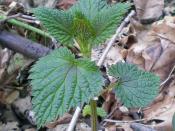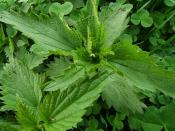Tall Nettles is about contrasts. Edward Thomas compares the natural growth of the nettles to the man-made objects - 'the springs, the rusty harrow, the plough'. Man-made things are 'long worn out' by springs of water, the many springs (the many change of seasons - time), but yet it is because of these natural things that the nettles thrive. No matter how clean and cultivated the farmer tries to make his yard, the dust and nettles will always survive - the refreshing rain 'springs' which gives the sense of purifying; only helps nature to grow, and at the same time corrodes man-made things. Not only does the poet consider nettles (nature) to be above unnatural things, but also he deems nettles to be tall and majestic as the trees 'only the elm butt tops the nettles now'. Also in the title he describes this weed as 'tall', meaning that the nettles are comparable to the trees in their beauty.
It is clear that Edward Thomas regards nettles - which sting and choke the life out of other plants; as useful creation - 'nettles cover up...these many springs, the rusty harrow, the plough long worn out' - the poet sees the nettles serving good, covering up the broken machines. It is clear that he also thinks that the nettles are much more beau tiful than the machines - the corner of the farmyard where they have taken over he describes as 'well as any bloom upon a flower' - not only does he compare the stinging nettles to huge graceful trees, but also to a beautiful flower. This poet is one who delights in the little things in life - even 'the dust on the nettles'.
The poem 'Two look at two' tells a story about two wanderers' desire for nature.


